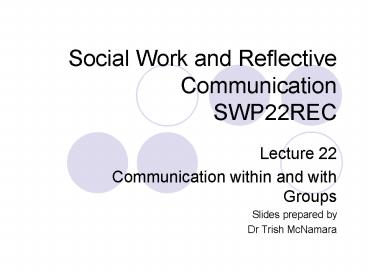Social Work and Reflective Communication SWP22REC - PowerPoint PPT Presentation
1 / 27
Title:
Social Work and Reflective Communication SWP22REC
Description:
a small collection of people who interact with each other, usually ... Social groups Parents without Partners, Car clubs, Scottish dancing, Book clubs etc. ... – PowerPoint PPT presentation
Number of Views:34
Avg rating:3.0/5.0
Title: Social Work and Reflective Communication SWP22REC
1
Social Work and Reflective CommunicationSWP22REC
- Lecture 22
- Communication within and with Groups
- Slides prepared by
- Dr Trish McNamara
2
What is a group?
- .a small collection of people who interact with
each other, usually face to face over time to
reach goals. - Adler and Rodman (2006) p. 262
3
Interaction
- Without interaction a collection of people
isnt a - group.
- Students in a lecture are not a group unless
they interact with each other and the
lecturer. - Adler and Rodman (2006) pp.262-263
4
Interdependence
- The behaviour of one person in a group effects
all others in the group
5
The Virtual Group - Advantages
- Computer mediated
- Does not meet face to face
- Facilitates contact despite challenges of time
and geography - Minimises power differentials
- Can be less threatening
6
Challenges with virtual groups
- Is open to confusing messages
- Is subject to the vagaries of IT
- Some members may lack resources to participate
fully - Some members are less able/willing to initiate
- Energy can lapse over time
7
Groups and Time
- A collection of people who gather together for
a short time is not a group - e.g. a group of people gathered to watch a fire
8
Size
- Adler and Rodmans (2006) definition of a
small group ranges from 3 to 7-20 members - p.264
9
Goals
- Usually one or more goals
- May be individual goals task or social
- May be group goals the collective aim(s)
- The less difference between the group goals and
the individuals goals the less conflict
10
Types of group
- Growth groups marriage encounter groups, group
therapy - Self help groups AA, Al Anon, Eating Disorders
Support Network, - Problem solving groups Neighbourhood Watch,
Kindergarten Committee - Social groups Parents without Partners, Car
clubs, Scottish dancing, Book clubs etc.
11
Characteristics of groups
- Rules attendance, homework etc
- Norms social, procedural and task
12
Family
- Rules (explicit)
- No chores, no allowance
- Phone home
- Fill the tank
- Sunday nights is family time
13
Family
- Norms (unstated)
- Dad in bad mood dont raise problems
- Keep off Sheilas divorce
- Tease Luke, not Sheila
- No trouble no questions
- Keep off sex, religion and politics at family
gatherings
14
On-the-job meetings
- Rules (explicit)
- Meetings every Monday at nine
- Rotating minute keeper
- Meetings last one hour
- No phone calls except emergencies
15
Norms (unstated)
- Use first names
- Challenge the boss briefly
- Jokes - but no sexual or ethnic topics
- Gut feelings need hard facts to back them
- Dont show distress if ones ideas are not
accepted - Adapted from Table 8.2 (Adler and Rodman, 2006 p.
273) - See also John Cleese in Meetings bloody meetings
Library Call no 658.456 M495
16
Roles
- Social
- Task
- Formal
- Informal
17
Some functional roles of group members
- Initiator/contributor
- Opinion seeker
- Coordinator
- Energizer
- Diagnostician
- Adapted from table 8.2 Adler and Rodman (2006)
18
Social/maintenance roles
- Supporter
- Harmoniser
- Tension reliever
- Conciliator
- Gatekeeper
- Feeling expresser
- Follower
19
Dysfunctional roles
- Blocker
- Aggressor
- Deserter
- Dominator
- Recognition seeker
- Joker
- Cynic
20
Four stages of group development in problem
solving groups
- Orientation
- Conflict
- Emergence
- Reinforcement
- Fisher cited in Adler and Rodman (2006)
21
Group dynamics
- Interacting forces in group communication
22
Group process
- Changing patterns in the dynamics of a group
23
Leadership
- A leader is best
- When people barely know
- That he exists
- Not so good when people obey and acclaim him
- Worse when they despise him
- Fail to honour people
- They fail to honour you
- But of a good leader who talks little
- When his work is done his aim fulfilled
- They will say We did it ourselves
- Lao-tzu
24
Leadership styles
- Laissez faire
- Authoritarian/autocratic
- Democratic
25
ve leadership traits
- Social nearness, friendliness
- Technical skills
- Group task supportiveness
- Task motivation and application
- Emotional balance and control
- Social and interpersonal skills
26
Common challenges for group leaders
- Information underload and overload
- Unequal participation
- Pressure to conform
27
Cultural influences on group communication
- Individualism versus collectivism
(Australia/Taiwan) - Power distance (New Zealand/France)
- Uncertainty avoidance (USA/Japan)
- Task versus social orientation (Austria/Norway)
- Short versus long term orientation
(Australia/Chinese countries) - Hofstede (1997)































